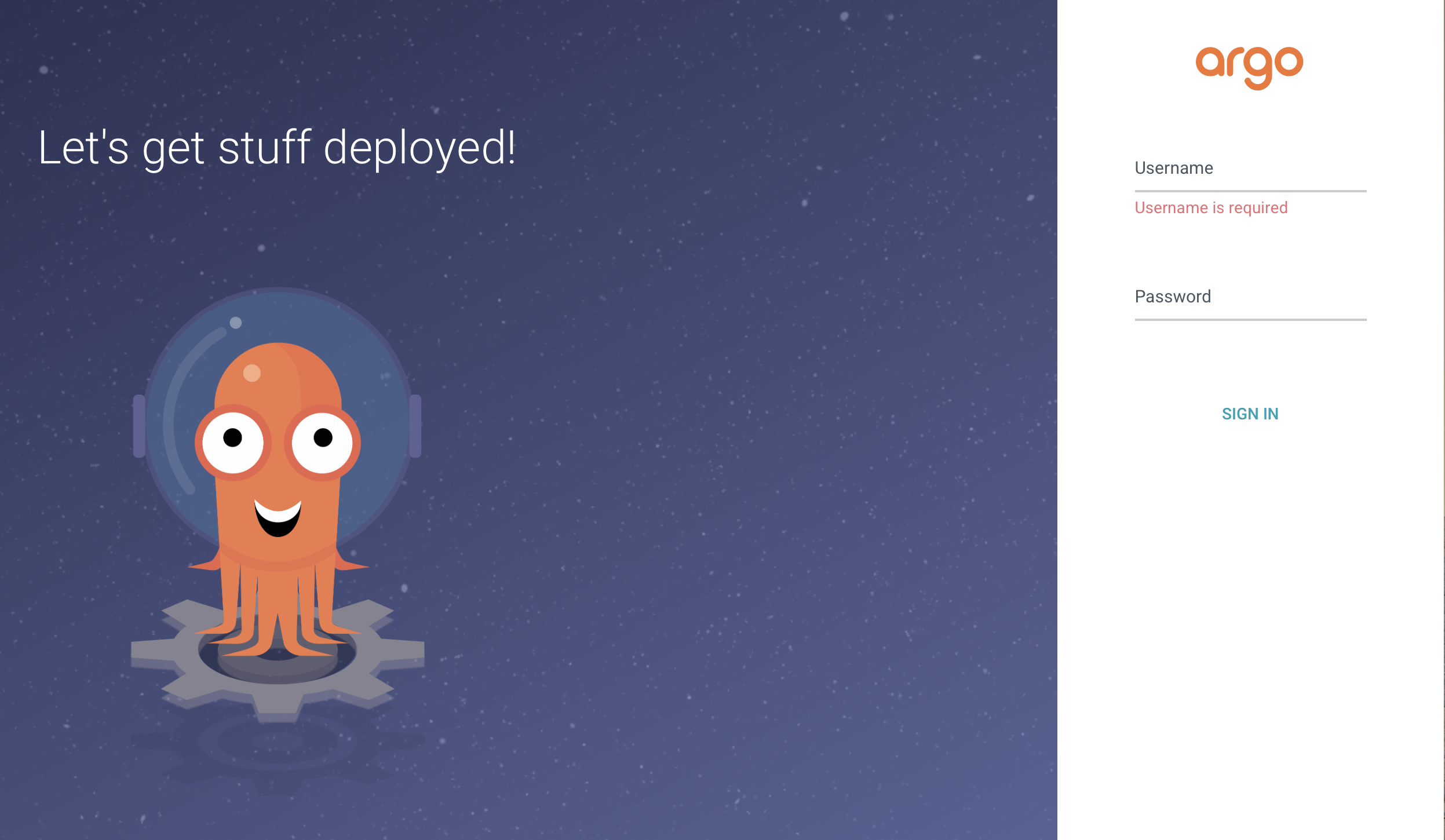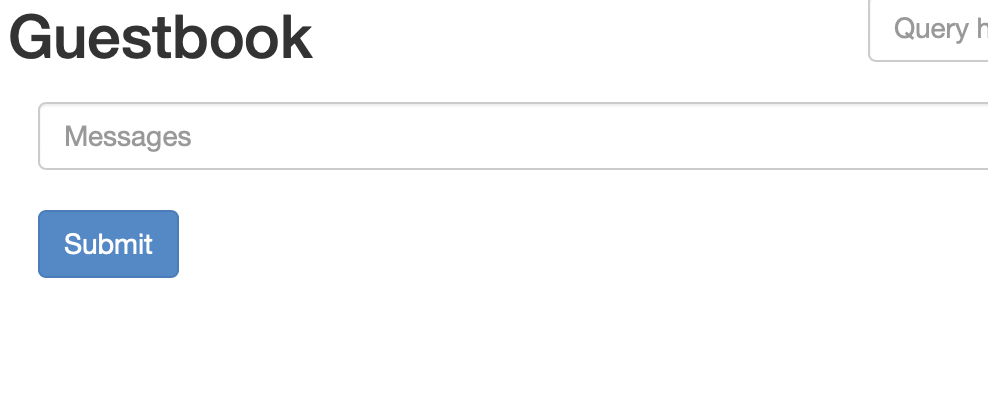Argo CD is an open-source GitOps continuous delivery tool. It monitors your cluster and your declaratively-defined infrastructure stored in a Git repository and resolves differences between the two — effectively automating an application deployment.
In this lab you will:
- Create an all-in-one Kubernetes cluster on the Ubuntu VM
- Install
kubectl - Deploy Argo CD
- Configure Argo to monitor a GitHub project
The following steps installed kubectl on the Ubuntu server.
Download the kubectl binary
curl -LO "https://dl.k8s.io/release/$(curl -L -s https://dl.k8s.io/release/stable.txt)/bin/linux/amd64/kubectl"
Add execute permissions
chmod +x kubectl
Move the kubectl binary to /usr/local/bin so it is in your $PATH
sudo mv kubectl /usr/local/bin/.
Install K3d cluster
curl -s https://raw.githubusercontent.com/k3d-io/k3d/main/install.sh | bash
k3d is a lightweight wrapper to run k3s (Rancher Lab's minimal Kubernetes distribution) in docker. k3d makes it very easy to create single- and multi-node k3s clusters in docker, e.g. for local development on Kubernetes.
Create a two-node K3d cluster
k3d cluster create testcluster --api-port 6443 --servers 1 --agents 1 --port "30500-30600:30500-30600@server:0"
This may take a few minutes, but should end with a message similar to:
INFO[0022] Cluster 'testcluster' created successfully!
INFO[0022] You can now use it like this:
To confirm you can communicate with the Kubernete's API run:
kubectl get nodes
You will see two nodes running
NAME STATUS ROLES AGE VERSION
k3d-testcluster-agent-0 Ready <none> 59s v1.25.7+k3s1
k3d-testcluster-server-0 Ready control-plane,master 63s v1.25.7+k3s1
GitOps uses Git as a “single source of truth” for CI/CD processes, integrating code changes in a single, shared repository per project and using pull requests to manage infrastructure and deployment.
Argo CD provides Continuous Delivery tooling that automatically synchronizes and deploys your application whenever a change is made in your Git repository. By managing the deployment and lifecycle of an application, it provides solutions for version control, configurations, and application definitions in Kubernetes environments, organizing complex data with an easy-to-understand user interface. It can handle several types of Kubernetes manifests, including Jsonnet, Kustomize, Helm charts, and YAML/json files, and supports webhook notifications from GitHub, GitLab, and Bitbucket.
Create the argocd namespace in your cluster, which will contain Argo CD and its associated services:
kubectl create namespace argocdAfter that, you can run the Argo CD install script provided by the project maintainers.
kubectl apply -n argocd -f https://raw.githubusercontent.com/argoproj/argo-cd/stable/manifests/install.yamlOnce the installation completes successfully, you can use the watch command to check the status of your Kubernetes pods:
watch kubectl get pods -n argocdBy default, there should be five pods that eventually receive the Running status as part of a stock Argo CD installation.
OutputNAME READY STATUS RESTARTS AGE
argocd-application-controller-0 1/1 Running 0 2m28s
argocd-dex-server-66f865ffb4-chwwg 1/1 Running 0 2m30s
argocd-redis-5b6967fdfc-q4klp 1/1 Running 0 2m30s
argocd-repo-server-656c76778f-vsn7l 1/1 Running 0 2m29s
argocd-server-cd68f46f8-zg7hq 1/1 Running 0 2m28s
You can press Ctrl+C to exit the watch interface. You now have Argo CD running in your Kubernetes cluster! However, because of the way Kubernetes creates abstractions around your network interfaces, you won’t be able to access it directly without forwarding ports from inside your cluster. You’ll learn how to handle that in the next step.
The argocd-server service is configured as a clusterIP type by default. This means the only way to access it is to use kubectl port-forward. However because we are connecting to a remote machine, we are going to expose the service.
Change the service type to NodePort
kubectl patch svc argocd-server -n argocd -p '{"spec": {"type": "NodePort"}}'
Now we need to open the service configuration and change the ports.
kubectl edit svc -n argocd argocd-server
Under the ports section, change the following:
- the http
nodePortto30501 - The https
nodePortto30502
So it looks like this
- name: http
nodePort: 30501
port: 80
protocol: TCP
targetPort: 8080
- name: https
nodePort: 30502
port: 443
protocol: TCP
targetPort: 8080Save the file and exit the editor.
Confirm you can access the Argo webUI in a browser by visting https://<IP_from_spreadsheet>:30502
Accept the warning and you should see something like this:
For the next steps, you’ll want to have the argocd command installed locally for interfacing with and changing settings in your Argo CD instance.
curl -sSL -o argocd-linux-amd64 https://github.com/argoproj/argo-cd/releases/latest/download/argocd-linux-amd64
sudo install -m 555 argocd-linux-amd64 /usr/local/bin/argocd
rm argocd-linux-amd64This in turn provides the argocd command. Before using it, you’ll want to use kubectl again to retrieve the admin password which was automatically generated during your installation, so that you can use it to log in. You’ll pass it a path to a particular JSON file that’s stored using Kubernetes secrets, and extract the relevant value:
kubectl -n argocd get secret argocd-initial-admin-secret -o jsonpath="{.data.password}" | base64 -d; echoYou can then log into your Argo CD dashboard by going back to https://<IP FROM SPREADSHEET>:30502 in a browser and logging in as the admin user with your own password:
Once everything is working, you can use the same credentials to log in to Argo CD via the command line, by running argocd login. This will be necessary for deploying from the command line later on:
argocd login <IP_FROM_SPREADSHEET>:30502You’ll receive the equivalent certificate warning again on the command line here, and should enter y to proceed when prompted. If desired, you can then change your password to something more secure or more memorable by running argocd account update-password. After that, you’ll have a fully working Argo CD configuration. In the final steps of this tutorial, you’ll learn how to use it to actually deploy some example applications.
Because we only have one cluster, the following is not applicable. It is good information for future deployments though.
Before deploying an application, you should review where you actually want to deploy it. By default, Argo CD will deploy applications to the same cluster that Argo CD itself is running in, which is fine for a demo, but is probably not what you’ll want in production. In order to list all of the clusters known to your current machine, you can use kubectl config:
kubectl config get-contexts -o name
test-deploy-cluster
test-target-clusterAssuming that you’ve installed Argo CD into test-deploy-cluster, and you wanted to use it to deploy applications onto test-target-cluster, you could register test-target-cluster with Argo CD by running argocd cluster add:
argocd cluster add target-k8sThis will add the additional cluster’s login details to Argo CD, and enable Argo CD to deploy services on the cluster.
Now that you have Argo CD running and you have an understanding of how to deploy applications to different Kubernetes clusters, it’s time to put it into practice. Use this repository of example applications that have been architected to showcase GitOps fundamentals. Many of these examples are ports of the same guestbook demo app to different kinds of Kubernetes manifests, such as Jsonnet. In this case, you’ll be deploying the helm-guestbookexample, which uses a Helm chart, one of the most durable Kubernetes management solutions.
In order to do that, you’ll use the argocd app create command, providing the path to the GitHub repository, the specific helm-guestbook example, and passing your default destination and namespace:
argocd app create helm-guestbook --repo https://github.com/jruels/argo-example-apps.git --path helm-guestbook --dest-server https://kubernetes.default.svc --dest-namespace defaultAfter “creating” the application inside of Argo CD, you can check its status with argocd app get:
argocd app get helm-guestbook
Output
Name: helm-guestbook
Project: default
Server: https://kubernetes.default.svc
Namespace: default
URL: https://localhost:8080/applications/helm-guestbook
Repo: https://github.com/argoproj/argocd-example-apps.git
Target:
Path: helm-guestbook
SyncWindow: Sync Allowed
Sync Policy: <none>
Sync Status: OutOfSync from (53e28ff)
Health Status: Missing
GROUP KIND NAMESPACE NAME STATUS HEALTH HOOK MESSAGE
Service default helm-guestbook OutOfSync Missing
apps Deployment default helm-guestbook OutOfSync MissingThe OutOfSync application status is normal. You’ve retrieved the application’s helm chart from Github and created an entry for it in Argo CD, but you haven’t actually spun up any Kubernetes resources for it yet. In order to actually deploy the application you’ll run argocd app sync:
argocd app sync helm-guestbooksync is synonymous with deployment here in keeping with the principles of GitOps – the goal when using Argo CD is for your application to always track 1:1 with its upstream configuration.
Output
TIMESTAMP GROUP KIND NAMESPACE NAME STATUS HEALTH HOOK MESSAGE
2023-04-20T06:28:06+00:00 Service default helm-guestbook OutOfSync Missing
2023-04-20T06:28:06+00:00 apps Deployment default helm-guestbook OutOfSync Missing
2023-04-20T06:28:07+00:00 Service default helm-guestbook Synced Healthy
2023-04-20T06:28:07+00:00 Service default helm-guestbook Synced Healthy service/helm-guestbook created
2023-04-20T06:28:07+00:00 apps Deployment default helm-guestbook OutOfSync Missing deployment.apps/helm-guestbook created
2023-04-20T06:28:07+00:00 apps Deployment default helm-guestbook Synced Progressing deployment.apps/helm-guestbook created
Name: argocd/helm-guestbook
Project: default
Server: https://kubernetes.default.svc
Namespace: default
URL: https://18.144.73.137:30502/applications/helm-guestbook
Repo: https://gitlab.com/jruels/argo-example-apps.git
Target:
Path: helm-guestbook
SyncWindow: Sync Allowed
Sync Policy: <none>
Sync Status: Synced to (53e28ff)
Health Status: Progressing
Operation: Sync
Sync Revision: 53e28ff20cc530b9ada2173fbbd64d48338583ba
Phase: Succeeded
Start: 2023-04-20 06:28:06 +0000 UTC
Finished: 2023-04-20 06:28:07 +0000 UTC
Duration: 1s
Message: successfully synced (all tasks run)
GROUP KIND NAMESPACE NAME STATUS HEALTH HOOK MESSAGE
Service default helm-guestbook Synced Healthy service/helm-guestbook created
apps Deployment default helm-guestbook Synced Progressing deployment.apps/helm-guestbook created
You have now successfully deployed an application using Argo CD! It is possible to accomplish the same thing from the Argo CD web interface, but it is usually quicker and more reproducible to deploy via the command line. However, it is very helpful to check on your Argo CD web dashboard after deployment in order to verify that your applications are running properly. You can see that by opening https://<IP FROM SPREADSHEET>:30502 in a browser:
At this point, the last thing to do is to ensure you can access your new deployment in a browser.
Just like before, the helm-guestbook service is configured as a clusterIP type by default. This means the only way to access it is to expose the service.
Change the service type to NodePort
kubectl patch svc helm-guestbook -p '{"spec": {"type": "NodePort"}}'
Now we need to open the service configuration and change the ports.
kubectl edit svc helm-guestbook
Under the ports section, change the following:
- the http
nodePortto30503
So it looks like this
ports:
- name: http
nodePort: 30503Save the file and exit the editor.
You can then open http://<IP FROM SPREADSHEET>:30503 in a browser window to see your example guestbook app:
Any further pushes to this GitHub repository will automatically be reflected in ArgoCD, which will resync your deployment while providing continuous availability.



